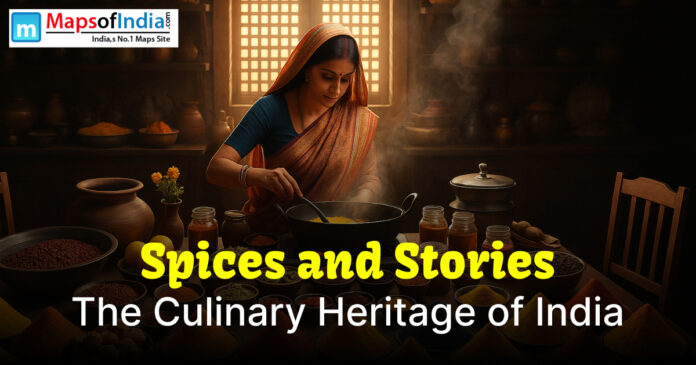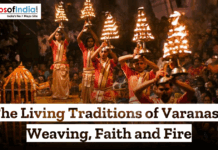Like its cuisine and foods, India is as much about its languages and cultures as it is about its diversity. Since every part of the Indian subcontinent has its own distinctive food, sites here document the history of cooking ingredients and spices. A dish can tell us a story about groups of people, how cultures changed, beliefs and ties between food and identity. Rather than only sharing recipes, this book shows how spices and dishes shape the unity of Indian culture.
The Spice Route and Historical Influences
Indian cuisine starts by celebrating its spices. Traders and invaders from afar have always been attracted to India, which is known as the world’s spice capital. Because of the ancient spice trade between India and Asia, as well as later Europe, Kozhikode, Goa and Kochi turned into lively hubs for spices. Black pepper, cardamom, cinnamon, turmeric and cloves were much desired and often considered to be just as valuable as gold.
Whenever the Persians, Mughals, Portuguese or British attacked or moved into India, new cooking practices and ingredients were introduced to kitchens here. The Mughals introduced the Indian kitchen to dishes such as biryani, gravies with rich sauces and a taste for nuts and dried fruits. Tomatoes, potatoes and chilli peppers came from the Portuguese and are now a key part of most Indian dishes.
Regional Cuisines: A Symphony of Flavors
India’s food is greatly influenced by its regions, dependent on climate, farming, local religions and the types of resources available.
North India: Robust and Royal
North India’s cuisine shows why it once had a royal tradition. Finding butter chicken, naan and dal makhani is common in Punjab, expressing the people’s preference for comfort food. Desi cuisine is full of ghee, cream and butter and dairy food is central to it. Once you move to Kashmir, you’ll come across the wazwan, which means eating rogan josh and gushtaba at special celebrations.
South India: Spice, Coconut, and Tradition
South Indian recipes are full of flavor, mixed with lots of spices and almost always include coconut. Tamil Nadu serves spicy Chettinad chicken, while in Andhra Pradesh, you can try the sharp gongura dishes. With its many backwaters and loads of seafood, Kerala prepares tasty dishes such as meen moilee and appam with stew. Karnataka’s Udupi cuisine is based on temple cooking and features vegetarian goodness without the addition of onion or garlic.
East India: Subtle and Soulful
The cooking in East India is quiet in flavor, but still comforting. Bengali dishes use both sweet and spicy ingredients, and a combination of fish, rice and mustard makes its unique style of cooking famous. Shorše ilish and chingri malai curry are famous Bengali dishes. The Odia people respect temple cuisine from the Jagannath Temple in Puri above all, especially Mahaprasad, which is not cooked with modern tools.
West India: A Fusion of Tastes
Western India, from the deserts of Rajasthan to the beaches in Goa, is home to many opposing environments. Many Rajasthani dishes — especially dal baati churma and gatte ki sabzi — are created with water conservation in mind. There is a distinct difference in Gujarat, where you’ll find multiple tasty veggie snacks such as dhokla, thepla and undhiyu. At the same time, Goan cuisine combines Hindu and Portuguese flavors, and two specialities are pork vindaloo and bebinca.
Central India: Tribal Flavors and Hidden Gems
Sometimes ignored, the area at the heart of India — including states like Madhya Pradesh and Chhattisgarh — has a humble food style linked to tribal culture. Bamboo shoot curries, sweets made with mahua fruit and leaf packet dishes cooked over the fire are a big part of tribal communities. Their authenticity is maintained because they haven’t changed due to commercial trends.
The Language of Spices
Spices in Indian cooking are often more than just things to add flavor; they show the stories behind recipes. It is habitual to use turmeric as an antiseptic, adding it to food and during ceremonies. Cardamom and saffron are used for their strong smells in most dishes. Garam masala is a unique mix of heat-inducing spices that is, in many homes, handed down like a legacy.
All Indian cooks develop the ability to know when and how much to add “tadka.” Together, the aromas of mustard, curry and cumin make it clear that something delicious is about to happen.
Street Food: The People’s Cuisine
The streets of India are bursting with delicious food. In every city, there is a famous snack food, whether it’s Mumbai’s vada pav, Delhi’s golgappas, Kolkata’s kathi rolls or Chennai’s sundal. They aren’t only meant for someone rushing, they also represent city life, bargain prices and new ideas.
Chaat started in the kitchens of the Mughal kings in Delhi but spread to become a food for everyone on most streets. Because puris are crispy, tamarind tastes tangy, yogurt is smooth and spices are bold, chaat tastes very chaotic, like India does.
Festivals and Food
Festivals in India are always connected to their local cuisine. Sometimes, Diwali’s aroma is the sweet smell of laddoos, barfis and gujiyas being cooked. An important part of Pongal in Tamil Nadu is the festive serving of the eponymous rice-lentil dish. Biryanis, sheer kurma and kebab are common in feasts at Eid, but Christmas celebrations include plum cake and sorpotel in Goa.
No matter what the festival is, food plays a key part—it shows how sharing a meal together unites all members of a family or community in good cheer.
The Role of Ayurveda and Sattvic Diets
Indian food is founded on ideas and practices meant for the body and mind. Food is placed into different categories by Ayurveda: sattvic, rajasic and tamasic. These diets which many spiritual communities use, are based on fresh fruits, vegetables, grains and dairy, with very little spice to nourish both body and mind.
Fermenting foods, fasting and eating detox recipes such as khichdi are also important within this healthy food approach. Indian cuisine is designed to keep the body healthy and balance its energies, in addition to making the diner full.
Indian Sweets: A Celebration in Every Bite
No discussion of Indian dishes would be complete without mentioning its desserts. There are many different kinds of Indian sweets such as gulab jamun, soan papdi, rasgulla from Bengal and Mathura’s peda, all of them delicious.
Most sweets have a history, either connected to religion or royal events. A range of foods began as offerings in temples and people would bring them over the years to community gathering and celebrations. To this day, sweets play a role in every important occasion such as births, weddings and festivals.
The Home Kitchen: A Sacred Space
Most Indian homes consider the kitchen more than simply a place to cook—it’s seen as sacred. People put out prepared meals — for the gods, for visitors and for the elders. Grandmothers cook traditional meals and daughters and granddaughters keep those recipes in their memories rather than writing them down.
For a long time, Indian homemakers have quietly helped to maintain our cultural traditions. Comprehension of how much flavor to add, what ingredients to use and the importance of proportions is basic to Indian cooking.
Conclusion: Preserving a Living Tradition
Indian cuisine is continuously changing, following new lifestyles, growth of cities and other worldwide trends. However, basically, it relies on remembering, repeating rituals and following traditions.
“Spices and Stories” means more than just an appearance; it prompts people to understand the people, history and origins of the foods. Whether it’s cooked in a palace or a village, served at a temple or a street stall, Indian food always shows its famous resilience, diversity and unity.
Since the world is becoming more global, we feel it is more important than ever to protect this culinary heritage by passing on respect for the culture and history in every traditional meal. Food in India isn’t just a meal — it shares a story as well.




